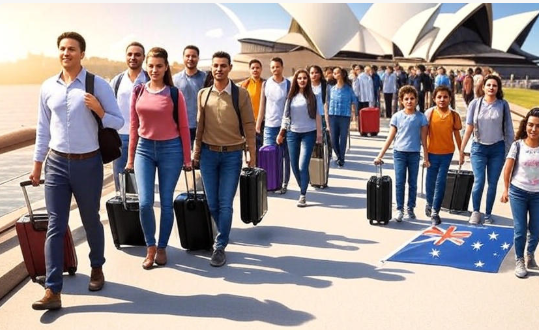Australia continues to be one of the most sought-after destinations for immigrants worldwide. With its high quality of life, robust economy, and diverse cultural landscape, it’s no wonder that thousands seek to make Australia their new home each year. However, the immigration process can be complex and requires careful planning, adherence to legal requirements, and a clear understanding of available pathways. In this article, we break down everything you need to know about how to immigrate to Australia legally, including visa types, eligibility, step-by-step application processes, and frequently asked questions.
Why Immigrate to Australia?
Before diving into the legal process, it’s essential to understand what makes Australia such an attractive destination:
- Stable economy with numerous employment opportunities
- Universal healthcare through Medicare
- World-class education systems
- Political stability and safety
- Multicultural environment with high acceptance of diversity
Australia consistently ranks high on global indices for quality of life, personal safety, public infrastructure, and environmental sustainability. Whether you’re seeking better career prospects, world-class education, or a safer place to raise a family, Australia offers compelling benefits.
Overview of Australia’s Immigration System
Australia operates a structured and points-based immigration system designed to attract skilled workers, reunite families, and provide refuge for those in need. Immigration is primarily managed by the Department of Home Affairs, which oversees all visa processing and enforcement of immigration laws.
There are multiple visa pathways, each with specific criteria, eligibility, and conditions. Understanding these categories is the first step toward immigrating legally.
Main Legal Pathways to Immigrate to Australia
1. Skilled Migration Visas
Skilled migration is one of the most popular routes to permanent residency in Australia. The General Skilled Migration (GSM) program is designed for individuals who possess skills in demand in the Australian labor market.
Key Visas in This Category:
- Subclass 189 (Skilled Independent Visa): For skilled workers not sponsored by an employer or state.
- Subclass 190 (Skilled Nominated Visa): Requires nomination by a state or territory government.
- Subclass 491 (Skilled Work Regional Visa): For applicants willing to live and work in regional Australia.
Eligibility Requirements:
- Age between 18 and 45
- Competent English proficiency
- Occupation listed on the Skilled Occupation List (SOL)
- Skill assessment by a relevant assessing authority
- Points test score of at least 65 (higher scores increase selection chances)
The GSM pathway allows migrants to live and work permanently in Australia, with the potential for citizenship in the future. State and territory nominations can enhance your chances by offering additional points or priority processing.
2. Employer-Sponsored Visas
These visas are ideal for individuals with job offers from Australian employers. The employer must be an approved sponsor, and the job must be on the eligible skilled occupation list.
Key Visas:
- Subclass 482 (Temporary Skill Shortage Visa)
- Subclass 186 (Employer Nomination Scheme)
- Subclass 494 (Skilled Employer Sponsored Regional Visa)
Key Considerations:
- The employer must demonstrate a genuine need for the position.
- Labor Market Testing (LMT) may be required.
- Pathway to permanent residency after a specified period.
Employer-sponsored pathways are often preferred by individuals who may not score high enough on the points test but can demonstrate value to an Australian employer.
3. Family and Partner Visas
Australia supports family reunification through various family-based visas. This includes partners, children, parents, and other relatives of Australian citizens or permanent residents.
Examples:
- Subclass 820/801 (Partner Visa – Onshore)
- Subclass 309/100 (Partner Visa – Offshore)
- Subclass 143 (Contributory Parent Visa)
Requirements:
- Proof of genuine and continuing relationship
- Health and character checks
- Sponsorship by an eligible family member
Partner and parent visas can be costly and have long processing times, but they offer a direct route to permanent residency and eventual citizenship.
4. Student Visas
While not a permanent solution, student visas can serve as a pathway to long-term residency.
Subclass 500: Student Visa
- Must be enrolled in a full-time CRICOS-registered course
- Requires Overseas Student Health Cover (OSHC)
- Allows limited work rights during study
Post-graduation, students can apply for:
- Subclass 485 (Temporary Graduate Visa)
- Apply for skilled migration or employer-sponsored visas
Many international students successfully transition to permanent residency through graduate or skilled pathways after completing their studies.
5. Business and Investment Visas
These visas are targeted at entrepreneurs, investors, and business owners looking to establish or invest in Australian enterprises.
Key Options:
- Subclass 188 (Business Innovation and Investment Provisional Visa)
- Subclass 888 (Permanent Visa)
Applicants must demonstrate business acumen, significant investment capital, and a clear economic benefit to Australia. There are multiple streams depending on your profile—entrepreneur, investor, or significant investor.
6. Humanitarian and Refugee Visas
Australia has a long-standing commitment to protecting refugees and those in humanitarian need.
Main Visas:
- Subclass 200 (Refugee Visa)
- Subclass 202 (Global Special Humanitarian Visa)
Applications are assessed on vulnerability, risk of persecution, and resettlement needs. These visas offer immediate permanent residency and access to support services.
7. Working Holiday Visas
This is a temporary visa for young adults (aged 18-30, or 35 for some countries) from eligible countries.
- Subclass 417 and 462
- Stay up to 12 months, extendable with specified work
While not a migration visa, it offers cultural exchange and can lead to other migration pathways. Working holidaymakers often transition into employer-sponsored roles or student visas.
Step-by-Step Guide: How to Immigrate to Australia Legally
Step 1: Identify Your Visa Type
Review your circumstances, goals, and qualifications. Use the Department of Home Affairs visa finder tool to explore suitable visas.
Step 2: Check Eligibility Criteria
Each visa subclass has unique requirements:
- Age
- English proficiency
- Skills assessment
- Health and character checks
- Financial means
Step 3: Skill Assessment (if applicable)
A formal skills assessment by an approved authority (like AITSL, Engineers Australia, ACS, or Vetassess) is mandatory for skilled migration visas. This step is crucial and must be done early.
Step 4: Submit an Expression of Interest (EOI)
For GSM visas, submit an EOI via SkillSelect, detailing your qualifications, experience, and intent. Make sure your information is accurate and up-to-date.
Step 5: Receive Invitation to Apply (ITA)
High-scoring EOIs may receive an ITA, prompting formal application submission within a specific time frame. Invitations are issued based on occupational ceilings and points ranking.
Step 6: Prepare and Submit Your Visa Application
Gather all required documents:
- Identity proof
- Academic transcripts
- Employment references
- English test results (IELTS, TOEFL, PTE)
- Medical checks
- Police clearances
Submit your application via ImmiAccount, the official portal for Australian visa applications.
Step 7: Await Processing
Processing times vary by visa type. Skilled visas can take 6-12 months, while partner and parent visas may take longer. You may be contacted for further documentation or interviews.
Step 8: Visa Outcome and Arrival
Upon approval, make travel arrangements. Understand your visa conditions and rights upon arrival. Comply with all visa terms to maintain legal status.
Step 9: Path to Permanent Residency and Citizenship
Temporary visa holders can transition to PR through specified streams. After holding PR for four years (with at least one year as a PR), you may be eligible for Australian citizenship. Ensure you meet residency and character requirements.
Legal Considerations and Compliance
Understanding how to immigrate to Australia legally involves more than just selecting the right visa. Legal compliance includes:
- Providing genuine and truthful information
- Complying with visa conditions (e.g., location, work rights, study requirements)
- Maintaining legal status (no overstays)
- Reporting changes in circumstances (e.g., change of address, marital status)
Non-compliance may result in visa cancellation or future ineligibility. It is your responsibility to stay informed.
Tips for a Successful Application
- Stay updated on immigration policy changes
- Avoid false claims – honesty is critical
- Use certified translations for all documents not in English
- Consider professional help from registered migration agents (MARA)
- Double-check documents before submission to prevent delays
- Prepare early – don’t wait until the last minute
Common Challenges and How to Overcome Them
Low Points Score
If you don’t meet the minimum 65 points, consider:
- Improving your English score
- Gaining more work experience
- Pursuing state nomination
- Studying in Australia
Failed Skill Assessment
- Re-check documentation and assessment authority requirements
- Seek guidance from professionals or your occupation’s registration body
Partner or Relationship Concerns
- Maintain detailed records of your relationship
- Provide strong supporting evidence: photos, messages, joint finances, etc.
Frequently Asked Questions
How can I know which visa is right for me?
Start by using the Department of Home Affairs visa finder tool and consult with a migration agent for personalized advice.
Is there an age limit to immigrate to Australia?
Yes, skilled migration visas typically have an age limit of 45 years. However, family and business visas may not have this restriction.
How long does the process take?
Processing times vary. A skilled migration visa can take between 6 to 18 months. Partner and family visas may take longer.
Can I work while waiting for my visa?
It depends on your visa conditions. Some bridging visas allow you to work while your application is being processed.
Do I need to use a migration agent?
No, it’s not mandatory. However, a registered migration agent can help ensure your application is complete and correctly submitted.
What are the common reasons for visa refusal?
- Incomplete or incorrect documentation
- Failing health or character checks
- Insufficient funds
- Not meeting eligibility criteria
Can I appeal a visa refusal?
Yes, depending on the visa type, you may be eligible to appeal through the Administrative Appeals Tribunal (AAT).
Can I include family members in my application?
Many visas allow dependents (spouse, children) to be included. Check individual visa criteria.
Are there English language exemptions?
Certain visa types and applicant profiles may be exempt. However, most skilled and student pathways require valid English proficiency tests.
Conclusion
Understanding how to immigrate to Australia legally is crucial for anyone considering a move to the country. With a wide range of visa options tailored to different needs, backgrounds, and professions, it’s essential to select the correct pathway and follow all legal requirements meticulously.
Whether you are a skilled worker, a student, a family member, or an investor, there is a structured path to becoming a legal resident in Australia. By staying informed, preparing thoroughly, and seeking expert advice when needed, you can greatly increase your chances of success.
Always refer to the Department of Home Affairs website for the most current and official information. Remember, the key to a successful application is not just desire—but preparation, compliance, and persistence.
This article is intended for informational purposes only and should not be construed as legal advice.












